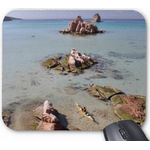In this stage we cover the capitals of the two most northwestern provinces of Argentina (also known as NOA): Salta and Jujuy. The two cities are separated about 63 mi. To go from Salta to Jujuy we use a secondary road that runs through the Yungas region.
Stage index:
From June 17 to 21, 2011: Salta
June 22, 2011: From Salta to Jujuy (Profile)
June 23, 2011: San Salvador de Jujuy
From June 17 to 21, 2011: Salta
 June 17 is a special day on Salta’s calendar: it commemorates the death of General Güemes, a local hero of the war against the royalists, i.e., the Spaniards. The most spectacular event of the celebration is undoubtedly the parade of hundreds of gauchos riding their horses through the city streets. Each gaucho association follows in formation their standard bearer. All men, women and children wear the mandatory Salta´s poncho, red wine color with two black stripes along (the same type we saw being manually woven near Seclantás, on the Calchaquí Valleys). Under the poncho they show off their best garments. Most men wear boots with spurs, baggy trousers inside the boots and tight at the waist by a decorated wide belt. The white shirt is almost hidden by a scarf and a jacket matching the pants. The more elaborated ones have decorations along the sleeves and legs. The straight-brimmed hat and the gaucho knife on the back complete the gaucho outfit. When riding, the legs are protected by a leather piece that attaches to the saddle. The women ride sideways, without the leather piece and wearing long skirts, which only reveal the shiny boots, and sometimes the white lace of the inner skirt. All of them ride with pride, some serious, others looking jovial. A few command their horses to execute artistic steps.
June 17 is a special day on Salta’s calendar: it commemorates the death of General Güemes, a local hero of the war against the royalists, i.e., the Spaniards. The most spectacular event of the celebration is undoubtedly the parade of hundreds of gauchos riding their horses through the city streets. Each gaucho association follows in formation their standard bearer. All men, women and children wear the mandatory Salta´s poncho, red wine color with two black stripes along (the same type we saw being manually woven near Seclantás, on the Calchaquí Valleys). Under the poncho they show off their best garments. Most men wear boots with spurs, baggy trousers inside the boots and tight at the waist by a decorated wide belt. The white shirt is almost hidden by a scarf and a jacket matching the pants. The more elaborated ones have decorations along the sleeves and legs. The straight-brimmed hat and the gaucho knife on the back complete the gaucho outfit. When riding, the legs are protected by a leather piece that attaches to the saddle. The women ride sideways, without the leather piece and wearing long skirts, which only reveal the shiny boots, and sometimes the white lace of the inner skirt. All of them ride with pride, some serious, others looking jovial. A few command their horses to execute artistic steps.
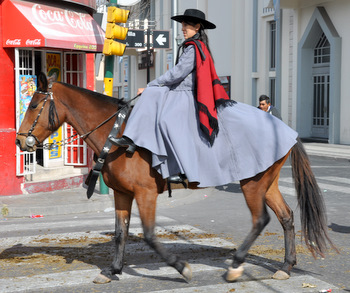 Salta is the first Argentine city we visit with a strong colonial character. Its best example: the Cabildo, the City Hall, located in the central plaza. The plaza is a cobbled square with a park in the center, surrounded by other beautiful buildings, including the Cathedral. It´s an island of peace in the bustling downtown streets, inviting you to sit on one of the outdoor tables of the cafes and enjoy the good weather while sipping a cup of espresso. Argentina is probably one of the few countries that still preserve the tradition of serving coffee with a glass of sparkling water, a tradition that although has been lost in Barcelona is still remembered by elders. In Argentina is even complemented with a cookie. Besides the historical monuments, its streets are a string of colonial houses, 1 or 2 stories high, double wooden doors with ornamental metal handles, friezes carved with heraldic shields (or at a minimum with the date of construction) and large windows protected by bars. Through some open doors we can see a central courtyard with colonnaded courtyards similar to monastery cloisters. Unfortunately, some of these courtyards, as well as the facades of many buildings need urgent restoration. The sidewalks are narrow and traffic is heavy, massively dominated by taxis and remises. There are almost no traffic lights, and if one can be found it sure is for the cars, not the pedestrians, which makes street crossing a risky activity. To the north of the city is Balcarce Street and its surroundings. This is an area where restaurants and pubs concentrate, mainly for tourists, especially the peñas. Salta is a folkloric capital, and its maximum exponent is precisely the peñas, gathering places for musicians and singers, where you can also dine or enjoy a drink. Traditionally, anyone could jump into the stage and start singing a song that will be followed by the public. In this tourist area, the peñas are more restaurants with a folklore show than anything else. Fortunately, we could find a peña that still retains its traditional character. This is at the Casona del Molino, west of the city, a country-house style restaurant with mostly local clientele (unlike the peñas in Balcarce) who knows and sings the songs the musicians play.
Salta is the first Argentine city we visit with a strong colonial character. Its best example: the Cabildo, the City Hall, located in the central plaza. The plaza is a cobbled square with a park in the center, surrounded by other beautiful buildings, including the Cathedral. It´s an island of peace in the bustling downtown streets, inviting you to sit on one of the outdoor tables of the cafes and enjoy the good weather while sipping a cup of espresso. Argentina is probably one of the few countries that still preserve the tradition of serving coffee with a glass of sparkling water, a tradition that although has been lost in Barcelona is still remembered by elders. In Argentina is even complemented with a cookie. Besides the historical monuments, its streets are a string of colonial houses, 1 or 2 stories high, double wooden doors with ornamental metal handles, friezes carved with heraldic shields (or at a minimum with the date of construction) and large windows protected by bars. Through some open doors we can see a central courtyard with colonnaded courtyards similar to monastery cloisters. Unfortunately, some of these courtyards, as well as the facades of many buildings need urgent restoration. The sidewalks are narrow and traffic is heavy, massively dominated by taxis and remises. There are almost no traffic lights, and if one can be found it sure is for the cars, not the pedestrians, which makes street crossing a risky activity. To the north of the city is Balcarce Street and its surroundings. This is an area where restaurants and pubs concentrate, mainly for tourists, especially the peñas. Salta is a folkloric capital, and its maximum exponent is precisely the peñas, gathering places for musicians and singers, where you can also dine or enjoy a drink. Traditionally, anyone could jump into the stage and start singing a song that will be followed by the public. In this tourist area, the peñas are more restaurants with a folklore show than anything else. Fortunately, we could find a peña that still retains its traditional character. This is at the Casona del Molino, west of the city, a country-house style restaurant with mostly local clientele (unlike the peñas in Balcarce) who knows and sings the songs the musicians play.
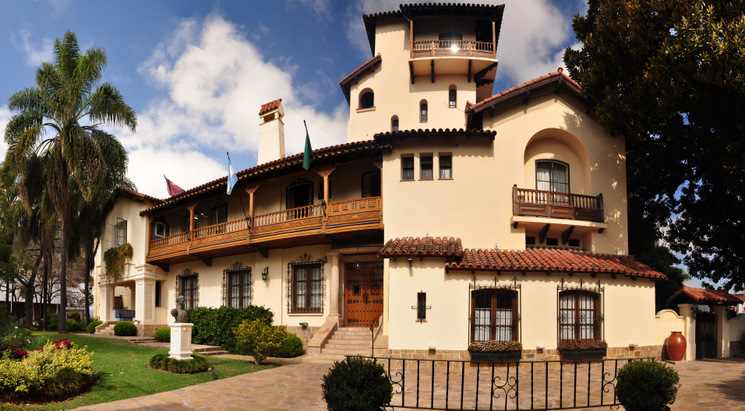
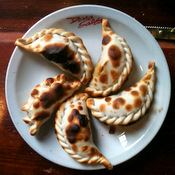 The empanadas from Salta are famous all over Argentina, in dispute for the first place with the ones from Tucumán. The empanadas are like the Spanish empanadillas. They differ in the stuffing though. The most common ones are beef or chicken, but you can also find the ones stuffed with charqui (air-dried meat), cheese and other varieties that are criticized by locals for not being the traditional ones. Empanadas can be tasted in the most sophisticated restaurants as well as in the street stalls. The best we try are in the Casona del Molino.
The empanadas from Salta are famous all over Argentina, in dispute for the first place with the ones from Tucumán. The empanadas are like the Spanish empanadillas. They differ in the stuffing though. The most common ones are beef or chicken, but you can also find the ones stuffed with charqui (air-dried meat), cheese and other varieties that are criticized by locals for not being the traditional ones. Empanadas can be tasted in the most sophisticated restaurants as well as in the street stalls. The best we try are in the Casona del Molino.
One of the museums that strikes us the most is the Museo de Arqueología de Alta Montaña (Archaeology Museum of High Altitude). It shows Inca archaeological remains found in the province. Most of them have been found in the summits of the Andes, buried in chambers as part of the offerings to their gods in what is called High Altitude Shrines. The museum is built around the important discovery of the high altitude shrine atop the volcano Llullaillaco at 20.000 feet, in 1999. There, they found the bodies of 3 children from the Inca culture along with about hundred objects. Among all the items, the little gold statues of men wearing finely woven robes and headdresses catch our attention. The cold, low atmospheric pressure, low humidity and thermal stability of the environment in which children and objects (textiles, bags of coca, headdresses, pottery, etc.) were buried have preserved them in an incredibly good condition. Undoubtedly, the most spectacular, controversial and somewhat macabre object shown is the body of one of the 3 children sacrificed. The child that is exposed at the time of our visit was about 7 years old. Like all men of the Inca elite, he has short hair and a headdress of white feathers behind the head, supported by a string around the forefront. The preservation state is so good that you can appreciate muscle tissues in the forearm and the little fingers. Among all the objects found next to the body a miniature llama caravan driven by richly dressed men stands out. Each of the elements that accompanied each of the children had a precise meaning depending on the position with respect to the body and its material. La doncella y la niña del rayo, as the two girls are known, are in cryopreserving chambers, where they are studied and preserved. Periodically, the body that is shown in the exhibition is removed from the displaying chamber, returned to the lab and replaced by another of the Llullaillaco children.
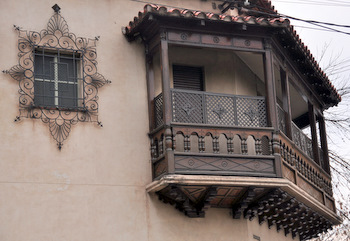 Another museum that is definitely worth visiting is the Pajcha Museum. This one includes pieces of several pre-Columbian cultures of all over Latin America and compares them with crafts that can still be found in Central and South America. In particular, it has a good collection of masks, Mapuche jewelry and fabrics from various cultures of the Peruvian coast. One of the major topics at the museum is the fusion of Catholicism and the pre-Hispanic religious believes that the indigenous artists reflected, either half hidden or very clearly, in altars, columns, friezes, paintings and so on. This section of the museum displays photos of friezes from different churches and cathedrals where the sun and moon gods blend with the saints and catholic iconography. It also shows paintings of dark-skinned virgins, more alike to the Indians. Diego, one of the museum's responsible, who guides us through the various rooms, tells us about the Arquebusier Angels. He advises us to visit the small church in Uquía, in the Quebrada de Humahuaca, where the original paintings are kept. In addition, he recommends the facades of some of the churches in Potosi to appreciate more examples of this Andean interpretation of Christianity.
Another museum that is definitely worth visiting is the Pajcha Museum. This one includes pieces of several pre-Columbian cultures of all over Latin America and compares them with crafts that can still be found in Central and South America. In particular, it has a good collection of masks, Mapuche jewelry and fabrics from various cultures of the Peruvian coast. One of the major topics at the museum is the fusion of Catholicism and the pre-Hispanic religious believes that the indigenous artists reflected, either half hidden or very clearly, in altars, columns, friezes, paintings and so on. This section of the museum displays photos of friezes from different churches and cathedrals where the sun and moon gods blend with the saints and catholic iconography. It also shows paintings of dark-skinned virgins, more alike to the Indians. Diego, one of the museum's responsible, who guides us through the various rooms, tells us about the Arquebusier Angels. He advises us to visit the small church in Uquía, in the Quebrada de Humahuaca, where the original paintings are kept. In addition, he recommends the facades of some of the churches in Potosi to appreciate more examples of this Andean interpretation of Christianity.
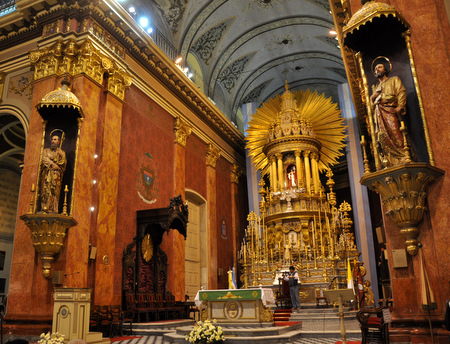 At the Cathedral we find a baroque central altar, richly ornated and covered with gold leaf. The side chapels of the same style have retablos of the Virgin wearing finely woven, embroidered with gold and silver dresses, and Jesus Crist crucified surrounded by gold and silver objects. We are also struck by the fervor of believers, many of them young. But again, the sign at the entrance of the cathedral reminds us of the duality between Christianity and Syncretism in which this society believes. The sign reads:
At the Cathedral we find a baroque central altar, richly ornated and covered with gold leaf. The side chapels of the same style have retablos of the Virgin wearing finely woven, embroidered with gold and silver dresses, and Jesus Crist crucified surrounded by gold and silver objects. We are also struck by the fervor of believers, many of them young. But again, the sign at the entrance of the cathedral reminds us of the duality between Christianity and Syncretism in which this society believes. The sign reads:
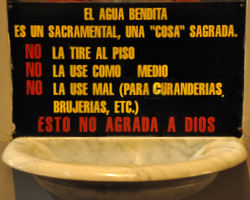 The holy water is a “sacred” thing.
The holy water is a “sacred” thing.
Don’t throw it to the floor
Don’t use it as a remedy
Don’t use it the wrong way (shamanism, witchery, etc)
God does not like that.
Besides satisfying our cultural needs, we do not overlook the importance of discovering Salta’s cuisine, from the most traditional one to the fusion with culinary creativity ;-). Our recommendations are in the side panel.
Go to top
June 22, 2011: From Salta to Jujuy
 The mountain road connecting Salta and Jujuy passes through a Yungas area, characterized by lush vegetation, lichen hanging from the trees branches and, of course, cloudy skies that provide humidity. The road goes above a gentle pass of 1200 feet. The traffic density is very low, since all vehicles use the main road to travel from one city to the other. Along the way we see flocks of urracas, parrots and two couples of woodpeckers. There are also a bunch of sheep and horses. The road goes around part of the reservoir Las Maderas. This reservoir has the peculiar shape of a hand and the road runs by the tip of several fingers.
The mountain road connecting Salta and Jujuy passes through a Yungas area, characterized by lush vegetation, lichen hanging from the trees branches and, of course, cloudy skies that provide humidity. The road goes above a gentle pass of 1200 feet. The traffic density is very low, since all vehicles use the main road to travel from one city to the other. Along the way we see flocks of urracas, parrots and two couples of woodpeckers. There are also a bunch of sheep and horses. The road goes around part of the reservoir Las Maderas. This reservoir has the peculiar shape of a hand and the road runs by the tip of several fingers.
This is not a spectacular route, but much better than the main road and even better than going through the stress of loading the bikes in a bus. Of course, both the departure and entry to the capitals are not pleasant, but both cities have bike lanes to relieve the worst part. In short, a nice and relaxed day, and an advisable route to go from Salta to Jujuy.
Go to top
June 23, 2011: San Salvador de Jujuy
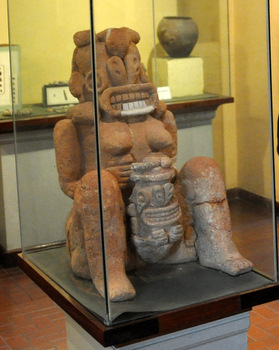 In Jujuy we visit the Archaeological Museum, the Cabildo and stroll through the streets. The museum contains a small collection of pottery in not very good condition, tools and other objects of the pre-Hispanic local cultures, as well as a section of deformed skulls for aesthetic purposes. But one piece stands out among all them. This is a 3000 year old statue carved in stone dedicated to the goddess of fertility: a woman giving birth, belonging presumably to the San Francisco culture that inhabited the Yungas area. The piece was found in a sugar cane field. In order not to obstruct the sugar production, the owner of the land donated the statue to the museum, but never allowed any site investigation. It seems that as the sugar cane is one of the main income sources for the province, the sugar companies have strong influences on the local government. Anyway, back to the sculpture, its peculiarity is that the appearance of the mother and child seem more of a culture from Central America, like the Olmec or Aztec, than one in northwestern Argentina.
In Jujuy we visit the Archaeological Museum, the Cabildo and stroll through the streets. The museum contains a small collection of pottery in not very good condition, tools and other objects of the pre-Hispanic local cultures, as well as a section of deformed skulls for aesthetic purposes. But one piece stands out among all them. This is a 3000 year old statue carved in stone dedicated to the goddess of fertility: a woman giving birth, belonging presumably to the San Francisco culture that inhabited the Yungas area. The piece was found in a sugar cane field. In order not to obstruct the sugar production, the owner of the land donated the statue to the museum, but never allowed any site investigation. It seems that as the sugar cane is one of the main income sources for the province, the sugar companies have strong influences on the local government. Anyway, back to the sculpture, its peculiarity is that the appearance of the mother and child seem more of a culture from Central America, like the Olmec or Aztec, than one in northwestern Argentina.
At the City Hall we visit the Chamber of the Flag that hosts the original flag of Jujuy created by general Belgrano. It also contains a flag for each one of the provinces. The Buenos Aires Federal District one is worth a side comment: an aggressive eagle showing a bifid tongue through the beak, with several equally fierce chicks at its feet. It fits very well its centralized-style government.
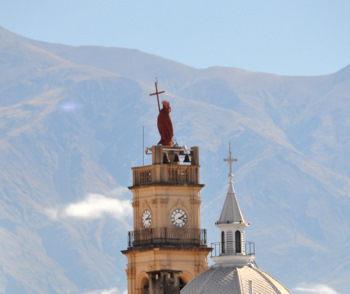 We also visit the Museum of Sacred Art in the Church of San Francisco. The guided tour, just for the two of us, is very illustrative. We see columns and wooden confessionals carved by the school of Potosi, as well as silver relics and a collection of paintings by Diego de Aliaga depicting the 14 stations of the Via Crucis (actually 13 because one of the paintings was lost). A violin catches our attention; introduced by the Jesuits in the seventeenth century, especially in the Chaco area, and now played in the chacareras, popular folk songs that use violins and charangos.
We also visit the Museum of Sacred Art in the Church of San Francisco. The guided tour, just for the two of us, is very illustrative. We see columns and wooden confessionals carved by the school of Potosi, as well as silver relics and a collection of paintings by Diego de Aliaga depicting the 14 stations of the Via Crucis (actually 13 because one of the paintings was lost). A violin catches our attention; introduced by the Jesuits in the seventeenth century, especially in the Chaco area, and now played in the chacareras, popular folk songs that use violins and charangos.
Jujuy, also known as 'the silver cup' , is a city with a modern atmosphere but still retains some colonial features (1 or 2 stories high houses with ornate friezes, large windows and some interior courtyards). It has a clear urban lifestyle with a rapid and decisive pace. Our perception is that there are many schools, but we cannot figure out the class schedule as there are children on the streets at any time. The upper part of the city is more quiet; a residential area with good views over the city.
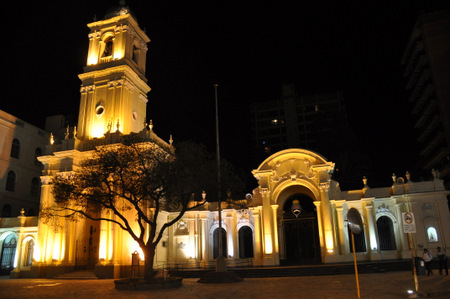
Go to top
© 2014 Explore Pangea. All Rights Reserved. Website
Terms
of Use.












